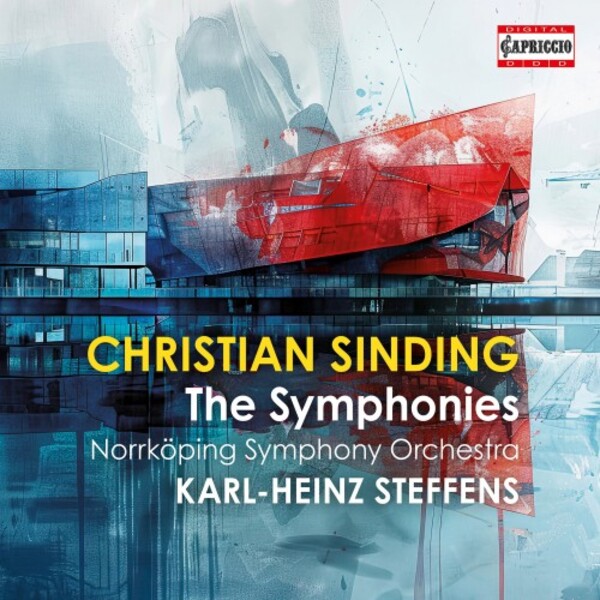SINDING Symphonies Nos 1-4 (Steffens)
View record and artist detailsRecord and Artist Details
Genre:
Orchestral
Label: Capriccio
Magazine Review Date: 03/2025
Media Format: CD or Download
Media Runtime: 150
Mastering:
DDD
Catalogue Number: C5540

Tracks:
| Composition | Artist Credit |
|---|---|
| Symphony No. 1 |
Christian (August) Sinding, Composer
Karl-Heinz Steffens, Conductor Norrköping Symphony Orchestra |
| Symphony No. 2 |
Christian (August) Sinding, Composer
Karl-Heinz Steffens, Conductor Norrköping Symphony Orchestra |
| Symphony No. 3 |
Christian (August) Sinding, Composer
Karl-Heinz Steffens, Conductor Norrköping Symphony Orchestra |
| Symphony No. 4 |
Christian (August) Sinding, Composer
Karl-Heinz Steffens, Conductor Norrköping Symphony Orchestra |
Author: Andrew Mellor
So Grieg was Norway’s miniaturist and Sinding its natural symphonist? I’m not so sure, and this complete set of the latter composer’s symphonies can’t persuade me Sinding’s erring towards Germanic argumentation rather than the indigenous Nordic music that so aided his compatriot made him any better at the creation of long-form symphonic work.
Sinding’s style didn’t change much but he evidently tried to alter the shapes in which it was presented, with the Second Symphony in three movements and the Fourth in seven, played continuously as a sort of symphonic rhapsody. But don’t let that latter fact lead you to think of Sibelius. Concision was not Sinding’s strong point (whatever his most famous piano work, Rustle of Spring, might suggest). Many of the symphonic movements on this, the only available recording of the complete symphonies from a single orchestra, land at the 10 minute mark. In almost every case, the material would have better suited six minutes or less.
Sinding’s Symphony No 1 is described in the booklet as ‘heterogeneous but conventionally romantic, occasionally sweeping’. It rambles. It wants to be imposing from its stern, thumping opening but ends up working very hard to no apparent ends. The clarinet theme that threads through the Andante is fleetingly interesting, with a more Mediterranean than Nordic feel, but where does it go? In the ensuing Vivace, what even is the theme, exactly? The blustery finale isn’t helped by the unerring feeling that its predecessor really wanted to have the symphony’s last word.
The Symphony No 2, mercifully, rollicks a little more and there’s the hint of some symphonic churn. The tenderness that was Sinding’s best asset emerges (at last) in the Andante, which has an attractive secondary theme and benefits from some stylish string-playing from the Norrköping Symphony Orchestra, but the third and final movement is stop-start – emblematic of the incessant mustering and subsequent dissipating that is a Sinding hallmark. That is even more apparent in the finale of the Symphony No 3, chronically unable to settle on an idea, whose music seems endlessly preparing for the presentation of a gesture or theme that never arrives. True, things get more structurally interesting in this score, and there’s the sense in the Allegro third movement that Sinding is beginning to glimpse a world for himself beyond the stringency of the Leipzig school even if, once again, there’s no apparent apotheosis.
Sinding devotees would want you to judge him on his Symphony No 4, which at last seems to go to another place – or, at least, visit it. The seven-minute opening Maestoso still works itself hard, but a new lightness emerges thereafter: tinkling piano, some sense of Wagnerian luminosity, space, distillation – all the things, actually, that make Grieg’s smaller-scale works so enchanting (though this is nowhere near as fresh or inspired). Could Sinding, in this symphony’s middle movements at least, be resting from the pressures of proving himself a diligent, hard-writing German-style composer?
As for the performances, they are decent, often shapely, though not rendered in the most high-definition sound. Turn to Thomas Dausgaard, marshalling the first two symphonies on CPO with the NDR Radiophilharmonie Hannover, and there is greater rhythmic pertness, more colouristic light and shade and a far more genial view of the music’s inner workings and tangential asides – especially in the First Symphony – aided by a more translucent recording that couches the big climaxes in more perspective. With the same orchestra, David Porcelijn can’t quite animate and clarify the music in his account of the last two symphonies like Dausgaard did, but even so the music still endears itself a little more than under Steffens and the argumentation feels less blunt. If and when I give Sinding a third chance, it’ll be CPO I turn to.
Discover the world's largest classical music catalogue with Presto Music.

Gramophone Digital Club
- Digital Edition
- Digital Archive
- Reviews Database
- Full website access
From £8.75 / month
Subscribe
Gramophone Full Club
- Print Edition
- Digital Edition
- Digital Archive
- Reviews Database
- Full website access
From £11.00 / month
Subscribe
If you are a library, university or other organisation that would be interested in an institutional subscription to Gramophone please click here for further information.




